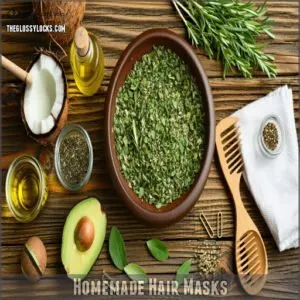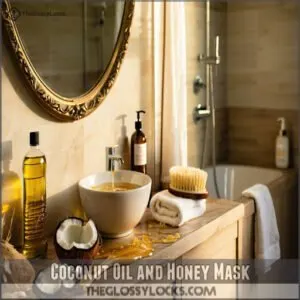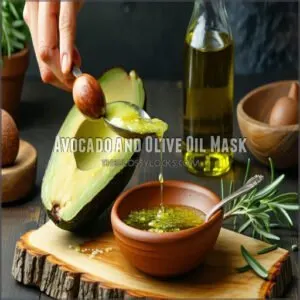This site is supported by our readers. We may earn a commission, at no cost to you, if you purchase through links.

Natural ingredients like avocado, honey, and coconut oil are key to achieving salon-worthy results at home.
These DIY masks offer deep conditioning, nourishment, and targeted treatments for specific concerns.
You can customize masks to fit your hair type and needs, whether it’s dry, damaged, curly, or oily.
The flexibility of DIY recipes lets you experiment with different ingredients to find your perfect blend.
Plus, you avoid potentially harmful chemicals found in store-bought products.
Ready to discover the secrets to shiny, healthy hair? Let’s go!
Table Of Contents
- Key Takeaways
- Homemade Hair Masks
- Hair Mask Applications
- DIY Hair Mask Recipes
- Hair Types and Masks
- Hair Growth and Strength
- Frequently Asked Questions (FAQs)
- What are homemade hair masks?
- How to apply the DIY hair mask and wash it out?
- How do you use a DIY hair mask?
- How do you make a hydrating hair mask?
- What is the best homemade hair mask?
- How do you make a 3 ingredient hair mask?
- How do you make a deep hydration hair mask?
- How often should I use a hair mask?
- How long should I leave a mask on?
- Can I use a hair mask daily?
- Conclusion
Key Takeaways
- You can make effective hair masks at home using natural ingredients like avocado, honey, and coconut oil. These masks offer deep conditioning, nourishment, and solutions for specific hair concerns like dryness, damage, or frizz.
- Homemade hair masks provide an empowering approach to hair care, allowing you to take control of the ingredients that go on your hair and avoid potentially harmful chemicals found in store-bought products.
- There are various ways to apply hair masks, including pre-shampoo treatments, post-shampoo masks, and leave-in treatments. Each method offers unique benefits, such as hydration, locking in moisture, or daily hair hydration.
- The article provides several DIY hair mask recipes targeting different hair types and concerns. For example, the coconut oil and honey mask is great for natural hair moisturizing, while the avocado and olive oil mask is perfect for hair nourishment and damage repair.
Homemade Hair Masks
Making your own hair masks is a fun, effective way to give your hair some extra TLC.
With simple, natural ingredients, you can create powerful treatments to transform your tresses, whether they’re dry, damaged, or dull, using natural ingredients.
Benefits of Homemade Hair Masks
Homemade hair masks are a natural way to nourish and treat your hair.
These DIY remedies offer a range of benefits, from deep conditioning to promoting hair growth.
By using natural ingredients like oils, fruits, and eggs, you can create customized treatments that target specific concerns, such as dry scalp, damaged hair, or frizz.
With homemade hair masks, you take control of what goes on your hair, avoiding potentially harmful chemicals found in some store-bought products.
It’s an empowering approach to natural hair care.
Common Ingredients for Homemade Hair Masks
Natural oils, hair butters, essential vitamins, herbal extracts, and amino acids are the MVPs of homemade hair masks.
These ingredients are like a dream team, working together to transform your tresses.
Think of olive oil, coconut oil, and avocado for moisture, or honey and egg yolk for strength.
With the right blend, you can create a natural hair treatment that rivals any salon visit, and become a DIY hair care pro using homemade hair masks.
So, get ready to whip up some hair mask recipes.
Tips for Choosing The Right Ingredients
When selecting hair mask ingredients, it’s vital to take into account your hair type and specific needs.
Here are some tips to guide your natural ingredient selection:
- Hair Type Analysis: Understand your hair type and specific concerns, such as dryness, damage, or oiliness.
- Ingredient Interactions: Be mindful of how ingredients work together. For example, combining coconut oil and honey creates a repairing mask.
- Mask Customization: Tailor your mask to target specific issues. Apply avocado and olive oil only to split ends.
- Product Compatibility: Verify the ingredients are suitable for your hair and scalp. Some ingredients, like coconut oil, can be adjusted for fine or thick hair.
- DIY Flexibility: Experiment with different ingredients and amounts to create homemade hair mask recipes that work best for you.
Considering the benefits of natural hair growth masks can also help you make informed decisions about your hair care routine.
Hair Mask Applications
There are various ways to apply hair masks, and each method has its own benefits.
We’ll explore pre-shampoo treatments, post-shampoo masks, and leave-in treatments, so you can choose the best option for your hair care routine.
Pre-Shampoo Treatments
Hair softening starts with a pre-shampoo treatment.
These hair moisturizing masks are like a tall drink of water for dry, thirsty hair.
Go ahead and massage your scalp with these hair nourishment tips.
Work the mask through your hair, giving yourself a little extra love with a scalp massage.
These deep conditioning treatments are a great way to give your hair some extra TLC.
To achieve the best results, consider using a pre shampoo treatment before your regular hair care routine.
So, if your hair is crying out for hydration, hair masks for hydration are the way to go.
Post-Shampoo Masks
Post-shampoo hair masks are your secret weapon for locking in moisture and nourishing your hair.
These masks are like a tall drink of water for your thirsty locks, helping to hydrate and repair damage.
Think of them as a boost to your regular routine, giving you salon-worthy results at home.
Using hair moisture treatments can greatly enhance the effectiveness of these masks.
These hair moisturizing masks are the perfect way to pamper yourself and your hair, leaving it feeling soft, healthy, and full of life.
Leave-in Treatments
Leave-in treatments are like a daily dose of self-care for your hair.
They’re the hair hydration tips that keep on giving, from hair serums to leave-in conditioners, hair oils to daily moisturizers, these products are designed to be left in your hair, soaking in all the goodness.
Overnight masks are another option for intensive hair moisturizing while you sleep, so if you’re looking for hair masks for hydration, leave-in treatments are a great way to go, providing a form of daily hair hydration.
DIY Hair Mask Recipes
Creating your own hair masks is a fun, effective way to give your locks some extra love.
We’ve put together a list of easy-to-make, nourishing hair mask recipes that you can whip up at home, using simple, natural ingredients.
Coconut Oil and Honey Mask
Coconut oil and honey masks are a sweet treat for your tresses, offering hair nourishment and scalp benefits, particularly for natural hair moisturizing and softening.
This dynamic duo is a go-to for natural hair moisturizing and softening, making it an ideal hair treatment.
Here’s a simple recipe for a coconut oil mask with a honey twist:
- Mix a tablespoon each of coconut oil and honey.
- Heat the blend until melted.
- Apply from roots to tips, then cover with a shower cap.
- Let it work its magic for 15–20 minutes.
This mask recipe is a quick fix for dry, damaged locks, leaving your hair happy and healthy, which is why incorporating coconut oil hair masks into your routine can have numerous benefits.
Incorporating coconut oil hair masks into your routine can have numerous benefits for your scalp and hair growth.
Avocado and Olive Oil Mask
Avocados and olive oil are a dynamic duo for hair nourishment.
Avocado benefits include vitamins and natural oils that moisturize and strengthen hair.
Olive oil uses include adding shine and smoothness to damaged hair.
Together, they’re a powerful DIY hair mask ingredient, sealing cuticles and leaving hair soft.
This avocado mask and olive oil mask recipe is simple: mash an avocado, mix with olive oil, and apply.
It’s a natural moisturizer, perfect for dry, dehydrated hair.
For a more advanced treatment, consider a hair mask recipe that incorporates additional ingredients for enhanced nourishment.
Egg and Lemon Mask for Oily Hair
Egg and lemon mask: a dynamic duo for oily hair care.
The egg whites and lemon juice in this mask work together to clarify your scalp and balance oil production.
Here’s how to make it:
- Crack an egg and separate the white from the yolk.
- Add a squeeze of lemon juice and whisk until smooth.
- Apply to damp hair, focusing on the roots.
- Sit back and relax for 30-45 minutes while the mask works its magic.
Rinse with shampoo and conditioner for refreshed, healthy-looking locks.
Banana and Yogurt Mask for Frizzy Hair
Battling frizz? This banana and yogurt mask is your new BFF.
Bananas are loaded with vitamins and minerals, making hair stronger and tamer. Yogurt’s natural proteins and probiotics nourish and smoothen hair.
Blend a sliced banana, 2 tablespoons of yogurt, and a drizzle of honey. Apply to damp hair, pop on a shower cap, and let it work its magic for 30–45 minutes.
Rinse, and say hello to smoother, frizz-free locks.
Hair Types and Masks
You’ll find the perfect hair mask for your specific hair type, whether you have dry, damaged, curly, frizzy, or oily hair.
Discover targeted solutions and learn how to address your unique hair concerns with simple and effective DIY recipes.
Dry Hair and Scalp Treatments
Is your dry hair and scalp feeling like a desert?
Quench your thirsty strands with moisturizing tips and hair masks for dry hair.
Coconut oil, a star ingredient in hair masks for moisture, penetrates the hair shaft for deep hair hydration.
Warm it up, massage into damp hair (avoiding roots for frizz control), and shampoo out in the morning.
This simple trick tackles dry scalp, split ends, and restores shine.
Combat dry hair with this moisturizing hair mask tip for intense hair hydration.
Damaged Hair Repair Masks
If your locks are looking a little worse for wear, it’s time to bring out the big guns with hair repair masks.
These super-charged treatments are like a spa day for your tresses, targeting specific issues like:
- Split Ends: Avocado and olive oil masks seal the cuticle, nourishing and softening hair.
- Frizz Reduction: Coconut oil tames thick, dry hair, and can be used as a pre-shampoo treatment or conditioner.
- Breakage Prevention: Honey strengthens hair, encouraging cell regeneration and calming irritation.
Using hair repair products can also enhance the effectiveness of these treatments.
So, go ahead and give your hair some TLC!
Curly Hair and Frizzy Hair Solutions
Curly hair, don’t care? Well, you should! Those curls need extra TLC to stay bouncy and defined.
Frizz is a common foe, but rice water and avocado come to the rescue. Soak rice, strain, then mash in avocado.
Apply this natural potion to your curls, and say goodbye to frizz. This curly hair care hack is a smooth operator, taming frizz and enhancing your curl pattern.
It’s a cheap and cheerful way to get your curls under control.
Oily Scalp Treatments
Battling an oily scalp? Hair masks are your secret weapon. They’re like a spa day for your scalp, purging gunk and excess oil.
Here’s how to whip that scalp into shape:
- Scalp Exfoliation: Slough away dead skin and product buildup with a scrub. Think of it as a deep cleanse for your scalp.
- Oil Control: Absorb excess sebum with a baking soda mask. No more greasy hair!
- Scalp Massage: Stimulate your scalp to promote blood flow and relax those tense muscles.
- Product Buildup: Cut through the gunk with a clarifying hair mask.
- Sebum Regulation: Balance your scalp’s oil production with hair masks that nourish without adding grease.
Get that scalp in check!
Hair Growth and Strength
You’ll be amazed at how simple kitchen ingredients like eggs, rosemary, and coconut oil can transform your lifeless locks into strong, growing hair.
Whether you’re dealing with breakage or slow growth, these natural masks will give your hair the nutrient boost it needs to thrive, providing a solution for strong, growing hair.
Promoting Hair Growth With Rosemary
Looking to supercharge your hair growth journey?
Rosemary oil’s carnosic acid works wonders by boosting scalp circulation and rejuvenating hair follicles.
Mix a few drops with coconut oil for a potent scalp massage that strengthens roots and fights premature graying.
For best results, use this herbal remedy 2-3 times weekly for six months, and just remember to dilute it properly and do a patch test first, to ensure you can safely use the rosemary oil.
DIY Masks for Hair Growth and Strength
While rosemary works wonders, you’ll find even more powerful DIY hair growth remedies in your kitchen.
Mix up these protein treatments that pack a serious punch:
- Blend aloe vera gel with rosemary oil and vitamin E for a scalp-stimulating mask that targets those stubborn thin spots
- Whip eggs with mashed avocado for a protein-rich strengthening treatment
- Combine coconut oil and shea butter for an intense moisturizing hot oil therapy
Massage these natural remedies into your scalp for 10 minutes – your roots will thank you.
Exfoliation and Scalp Treatments for Healthy Hair
While you’re working on stimulating growth, don’t forget about that foundation: your scalp.
Mix two tablespoons of brown sugar with coconut oil for a gentle scalp massage that’ll sweep away buildup.
Your DIY hair exfoliants should feel like a mini spa day – work the scrub in circular motions, focusing on areas that need extra TLC.
Weekly scalp care keeps flakes at bay and boosts circulation naturally.
Split End Repair and Prevention Masks
While a healthy scalp sets the foundation, those pesky split ends need special attention for complete hair repair.
Understanding the concept of hair growth is essential in addressing split ends.
Your journey to damage prevention starts with these proven split end masks that seal and protect:
- Mix avocado with olive oil for deep hair nourishment
- Combine honey and olive oil to combat hair breakage
- Blend coconut oil with fish oil for intensive frizz control
- Create a yogurt-honey fusion for total damaged hair repair
Frequently Asked Questions (FAQs)
What are homemade hair masks?
Hair masks are like a spa day for your strands, bringing life back to dull, damaged locks.
Homemade masks use natural ingredients like avocado, honey, and olive oil to nourish and strengthen hair.
How to apply the DIY hair mask and wash it out?
You might be thinking, "How do I avoid making a mess with these DIY hair masks?"
Well, it’s simpler than you think.
First, apply your chosen mask to dry hair, focusing on the areas that need it most.
Let it work its magic for the recommended time, then hop in the shower and rinse with warm water.
Shampoo and condition as usual—no need for extra steps, and remember to apply the mask as part of your routine to dry hair.
How do you use a DIY hair mask?
You’ll want to prep your hair first.
Start with damp, not soaking wet hair. Then, section it off.
Apply the mask evenly, focusing on the areas that need it most. Finally, pop on a shower cap and relax!
How do you make a hydrating hair mask?
Mix a tablespoon of coconut oil and honey.
Heat and apply from roots to tips.
Let it sit for 15–20 minutes.
Rinse.
For dry hair, add an egg yolk, rich in vitamins, and leave on for an hour.
What is the best homemade hair mask?
Soothe and strengthen your strands with a simple solution.
Stir up a blend of coconut oil and honey for a repairing mask.
Or, for hair growth, combine coconut oil and cinnamon, massaging the mixture into your scalp.
How do you make a 3 ingredient hair mask?
You’re after a simple, effective 3-ingredient hair mask?
Try this: Mash a banana with a tablespoon of olive oil and a tablespoon of honey.
Apply to damp hair, leave for 30 minutes, then rinse.
Easy!
How do you make a deep hydration hair mask?
Imagine your hair is a thirsty desert.
What’s the remedy? A deep hydration hair mask, of course.
Coconut oil, honey, and banana to the rescue. Mix, apply, and let your hair drink it up.
Rinse, and say hello to moisturized, happy locks, thanks to the coconut oil.
How often should I use a hair mask?
You don’t want to overdo it, so aim for once a week.
This gives your hair a regular boost without weighing it down.
Think of it like a spa day for your strands—a weekly ritual for healthy, happy hair.
How long should I leave a mask on?
The timing varies with each mask, but generally, you’ll want to leave your hair mask on for at least 10 minutes so that your strands can soak up all the nourishing goodness.
For deeper conditioning, aim for 20 to 30 minutes, and always follow the mask’s instructions.
Can I use a hair mask daily?
Imagine a lush garden. You water daily, but plants wither. Overwatering drowns roots. Same for hair. Daily masks overload strands and scalp. Space treatments for healthy, happy hair.
Conclusion
Your hair is your crowning glory, and with these homemade hair mask recipes, you can quite literally wear that crown with pride.
You’re now equipped with five easy DIY recipes that will nourish and transform your locks, catering to various hair concerns.
So, get mixing, and watch your hair shine!













